Architecture Photography in Las Vegas
Two things we here at Square Shooting love is architecture photography and the city we call home: Las Vegas. We’ve had plenty of architecture photography assignments over the years, but our favorite project was when the City of Las Vegas asked us to capture the most notable buildings in the downtown area.
The city of Las Vegas is know for gambling, pool parties, bottle service, and all the big buffets. The city is also know for flashy casinos, which mostly live on one very famous street. Outside of those resorts, most people do not put much thought into the art of architecture photography in Las Vegas. We here at Square Shooting have put a lot of thought into the topic. As a result, we have captured some of the most historic and architecturally important buildings that make Las Vegas the most unique city in the world.
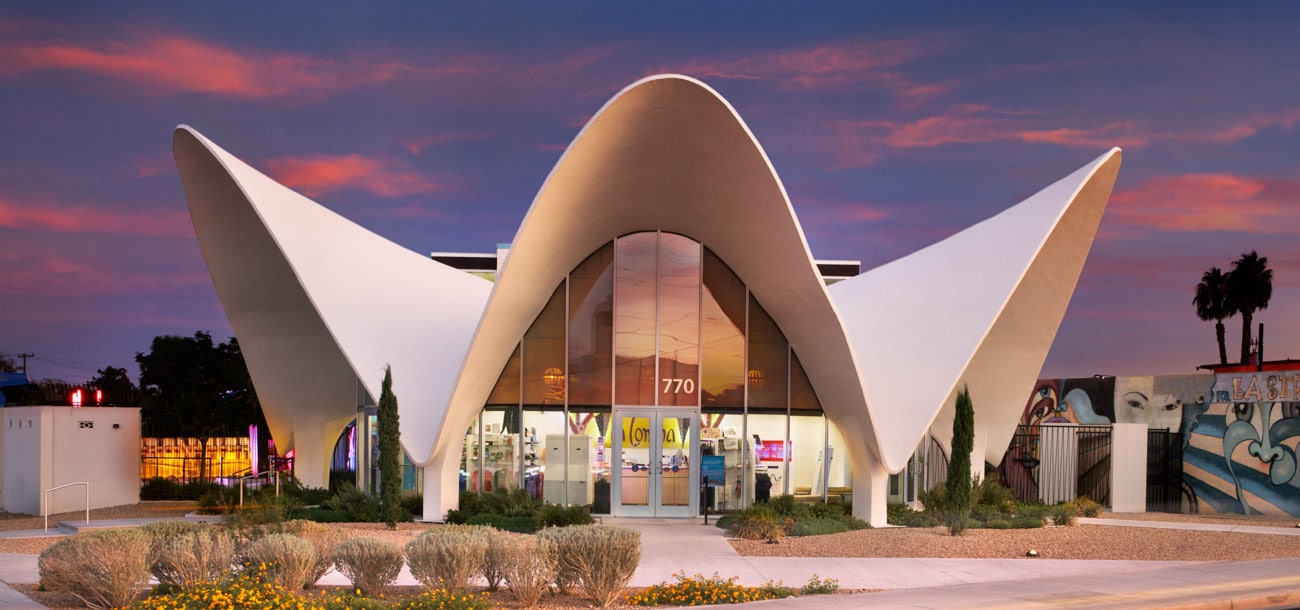
Architecture Photography in Las Vegas The Neon Museum
La Concha / The Neon Museum
This building is one of the most daring designs to ever dot the landscape of Sin City. Originally it once the lobby to the historic La Concha Motel. It now serves as a visitor center for the Neon Museum. Unlike a lot of historic buildings in Las Vegas, this was saved from being torn down. It was physically moved in 2006 to its current home. This huge task helped in preserving architect Paul Revere Williams‘ Mid-Century Modern design that was built in 1961. The dramatic scale of the arches makes it an unforgettable building. Above all, it is easily recognized by even the simplest of sketches on paper. This very unique design is a joy to look at, but also a tale of history.

Las Vegas Fifth Street School
The Fifth Street School
Built in 1936, this building holds a special place in many hearts under its original name of the Las Vegas Grammar School. Then in 2008 it had a rebirth when the Las Vegas Redevelopment Agency repurposed the building. After that, it became known as the Fifth Street School. Not many know that Fifth Street is the old name of Las Vegas Boulevard. It houses the University of Nevada Las Vegas Fine Arts Program, Downtown Design Center for the School of Architecture, and much more. It is also available for private functions, with many different areas for groups to mingle. With its mission style architecture, this building has quite a wide footprint, which has little eye-catching details all around. A true gem in Las Vegas.
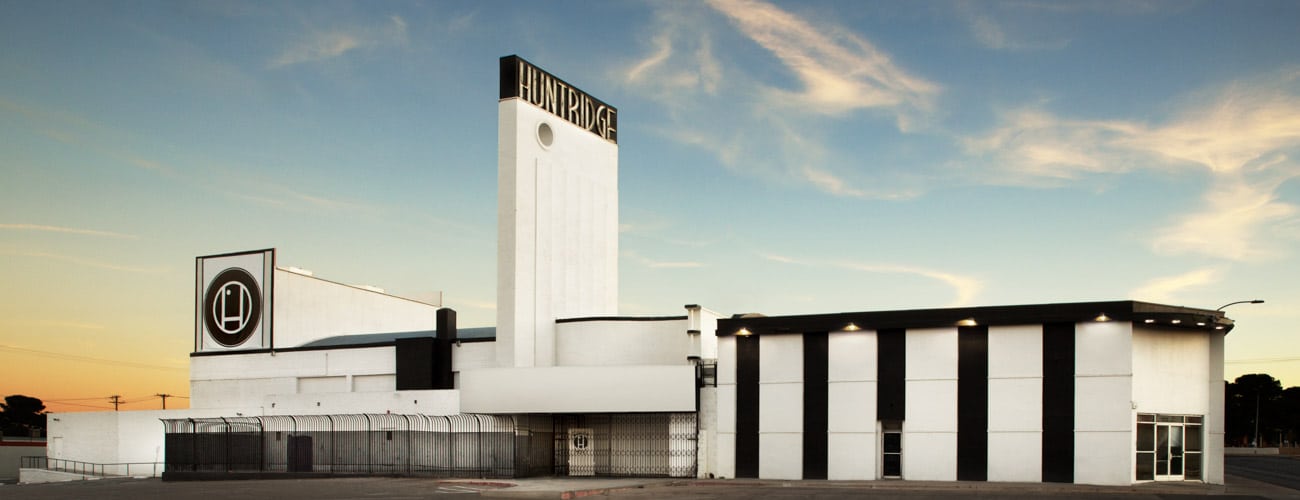
Huntridge Theatre
Huntridge Theatre
Unlike any other building in the Las Vegas Valley, the Huntridge Theatre has been part of the culture for over seventy five years. Built in 1944, it became the first non-segregated theater in Las Vegas. The building was a movie theater in the 60’s through the 80’s. After that, it became a prominent music and performance venue until the roof collapsed in 1995. Eventually the Huntridge closed its doors in 2004. That would not stop the community from loving it. A nonprofit named ‘The Huntridge Foundation’ started up in 2012 with a new mission. In 2013 the community raised $207,355 to help the aging landmark. A new paint job gave it a fresh look, but still sits vacant waiting for its next life.
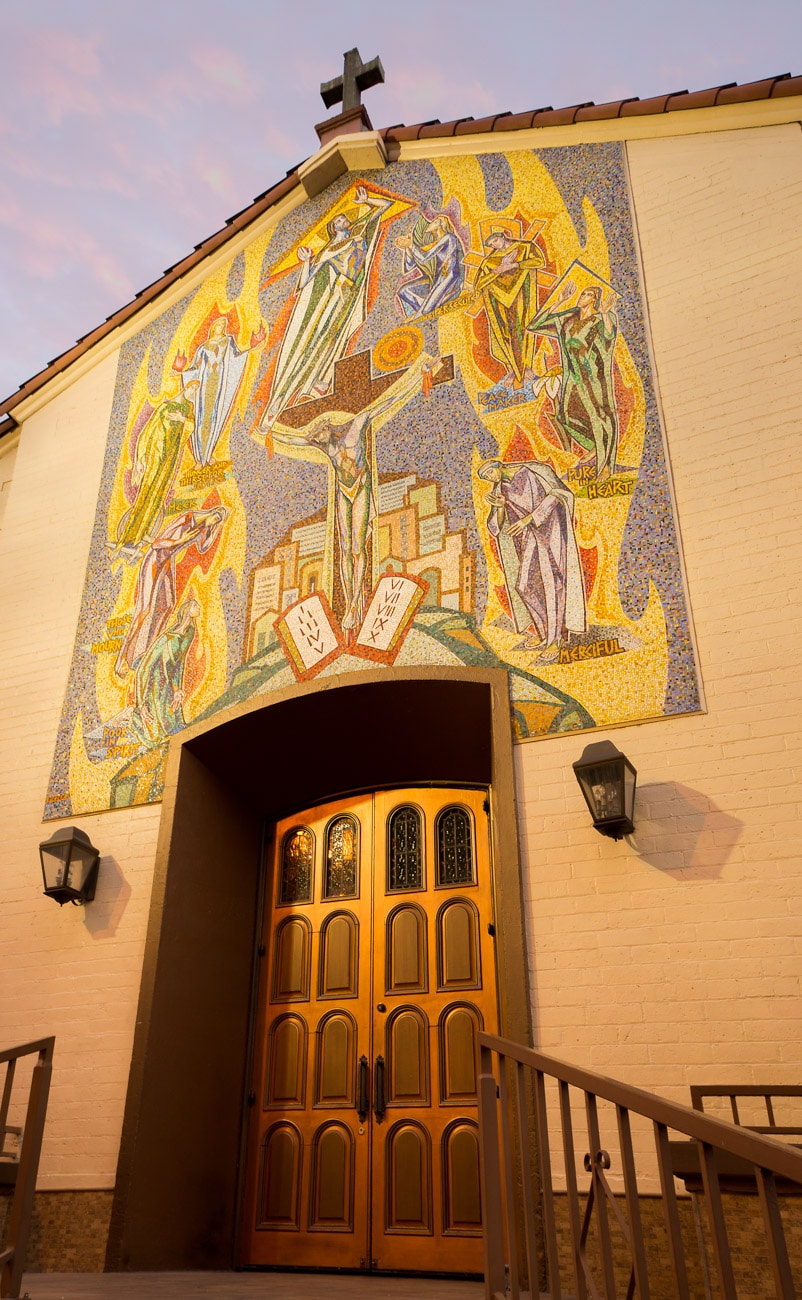
St. Joan of Arc Parish
St. Joan of Arc Parish
Las Vegas was established in 1905, and four years later a plot of land was purchased on what is now known as Casino Center Blvd. This land became the home to the first church. A tiny wooden structure known as the Cottage Chapel that was constructed in 1910. The parish continued to grow like the city itself. In no time, a new building was made for the large number of people calling Las Vegas home. In 1941, this version of the church was built by David Lorenzi in the original location of the Cottage Chapel. This tiny church seems like a needle in a haystack in today’s setting. An iconic part of Vegas’ history hidden by the city’s office and legal buildings.
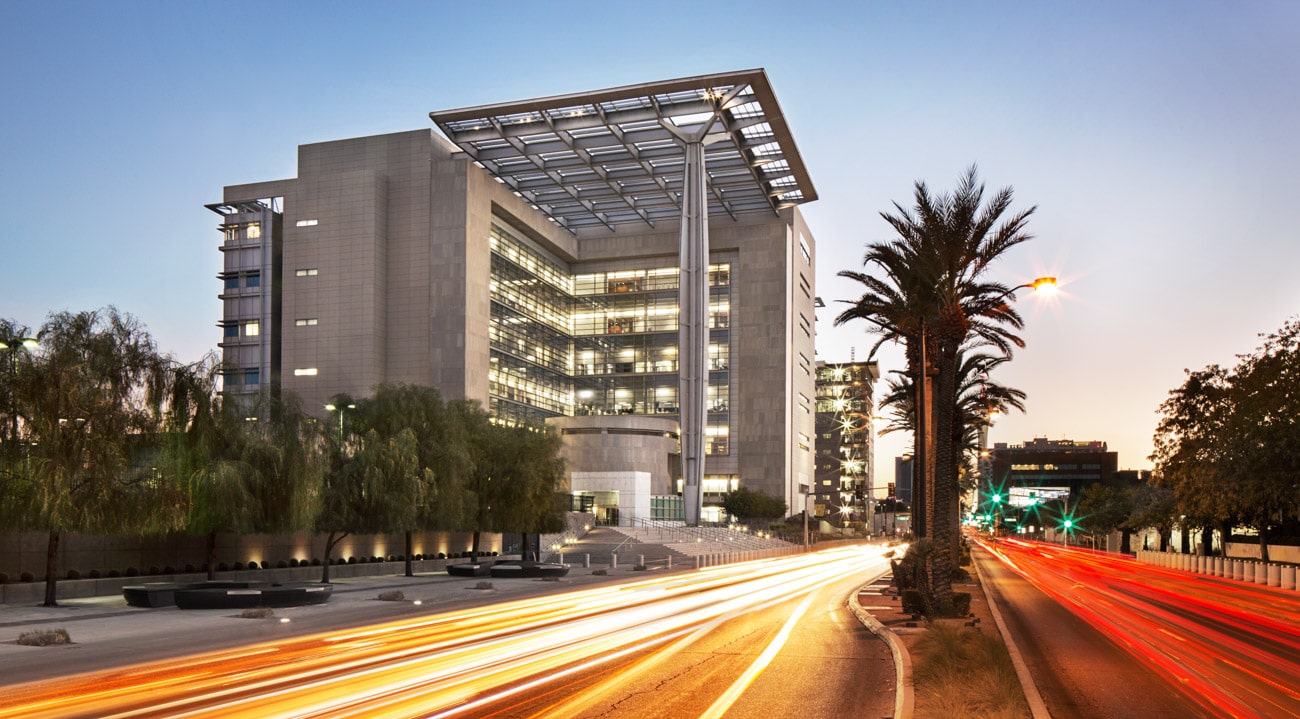
Lloyd D. George Federal District Courthouse
The Lloyd D. George Federal District Courthouse
It is hard to miss this building while driving down Las Vegas Blvd based on the huge size alone. The architectural details and landscaping make the building even more impossible to ignore. The courthouse was built and completed in 2002. It is the first federal building to comply with blast requirements that were put into place after the Oklahoma City blast in 1995. One of the eye-catching elements of this building is the landscaped sidewalks with large seating areas and full size trees for shade, for instance. The most recognized piece of the architectural design is the dynamic canopy supported by 160-foot column over the plaza’s main entrance.
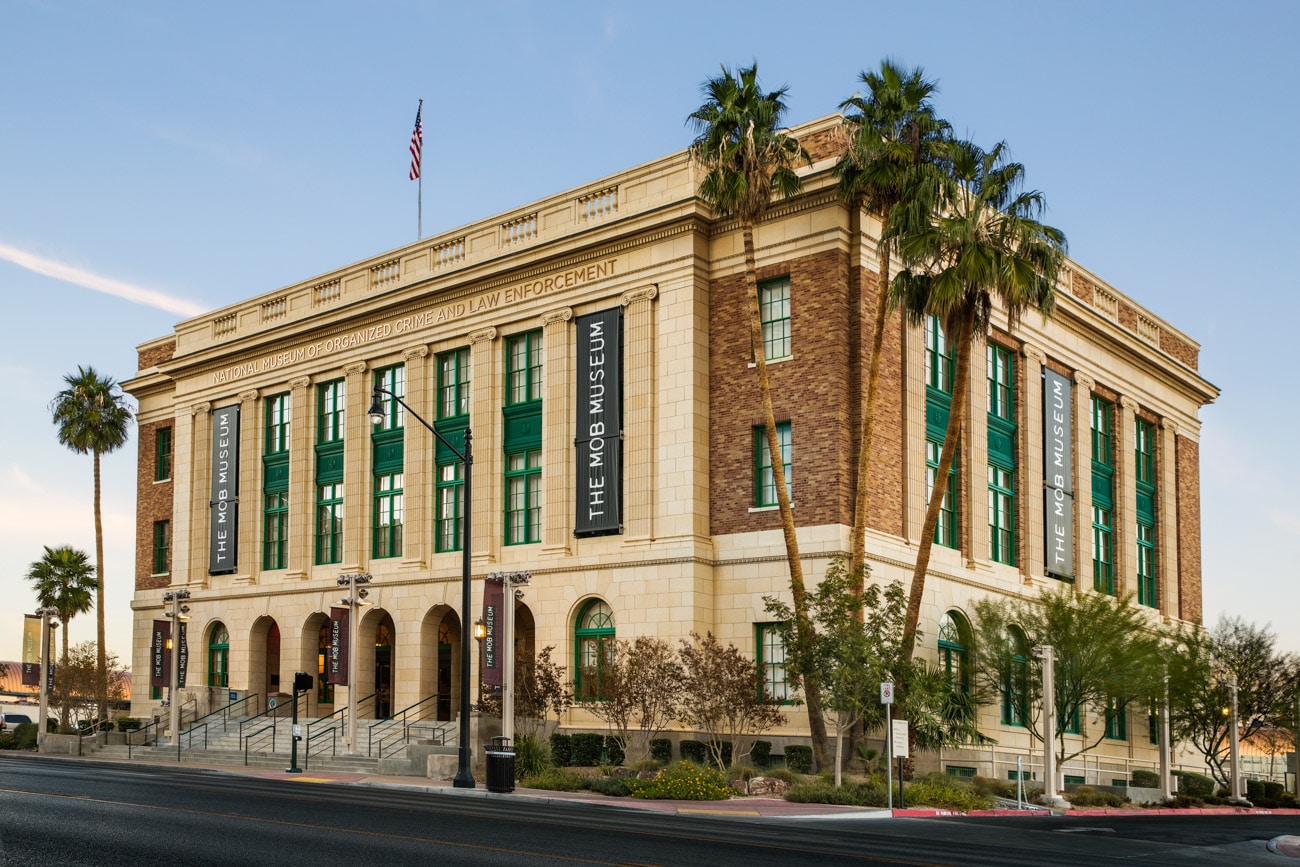
Architecture Photography in Las Vegas The Mob Museum
The Mob Museum
Originally built in 1933, this was the Las Vegas Post Office and Courthouse for decades. After that, it was placed on the National Register of Historic Places in 1983. In 2000 it was sold to the City of Las Vegas for a mere one dollar. Because of this deal, there was agreement that it would be restored and have a cultural mission. Las Vegas’ then Mayor Oscar Goodman was previously a defense attorney to the mob and had an idea for the Mob Museum in 2002. On Valentines Day 2012, the Mob Museum opened its doors to highlight the history of organized crime and law enforcement, and how it shaped Las Vegas.
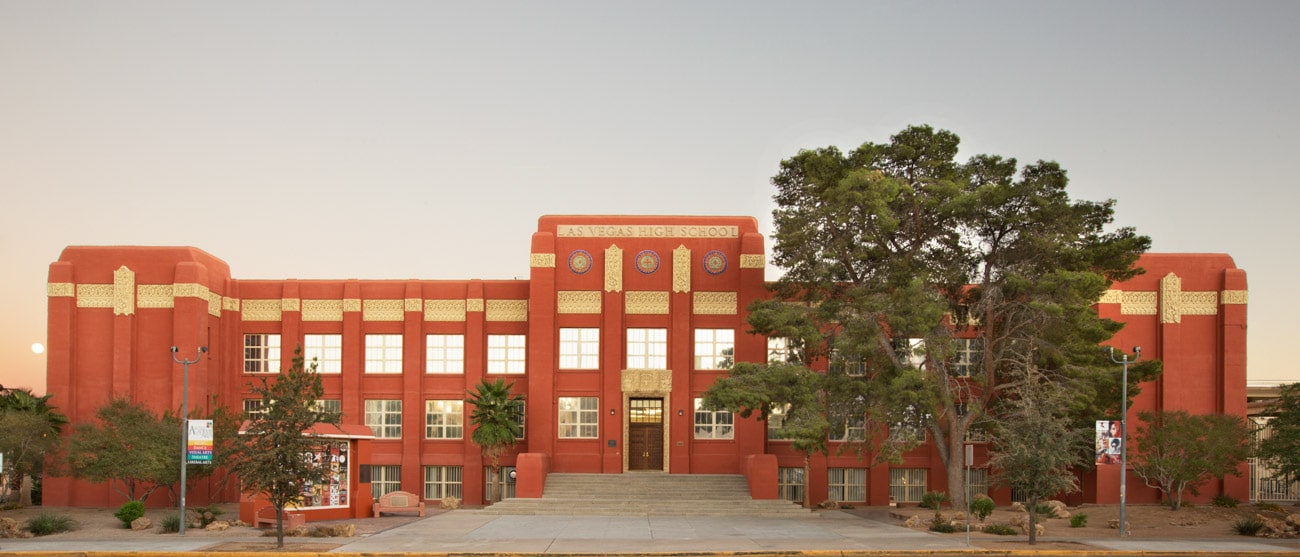
Las Vegas Academy of the Arts
Las Vegas Academy of the Arts
The first high school in Las Vegas, this art-deco building opened in 1931. Originally it was thought to be too far from the city. However, that turned out not to be the case. Over time, the city has grown all around the building and beyond. Only two of the original buildings still remain today and both are listed on the National Register of Historic Places. In 1993 the school reopened as a magnet school renamed the Las Vegas Academy of the Arts. Here students are educated on performing and visual arts, in addition to international studies.
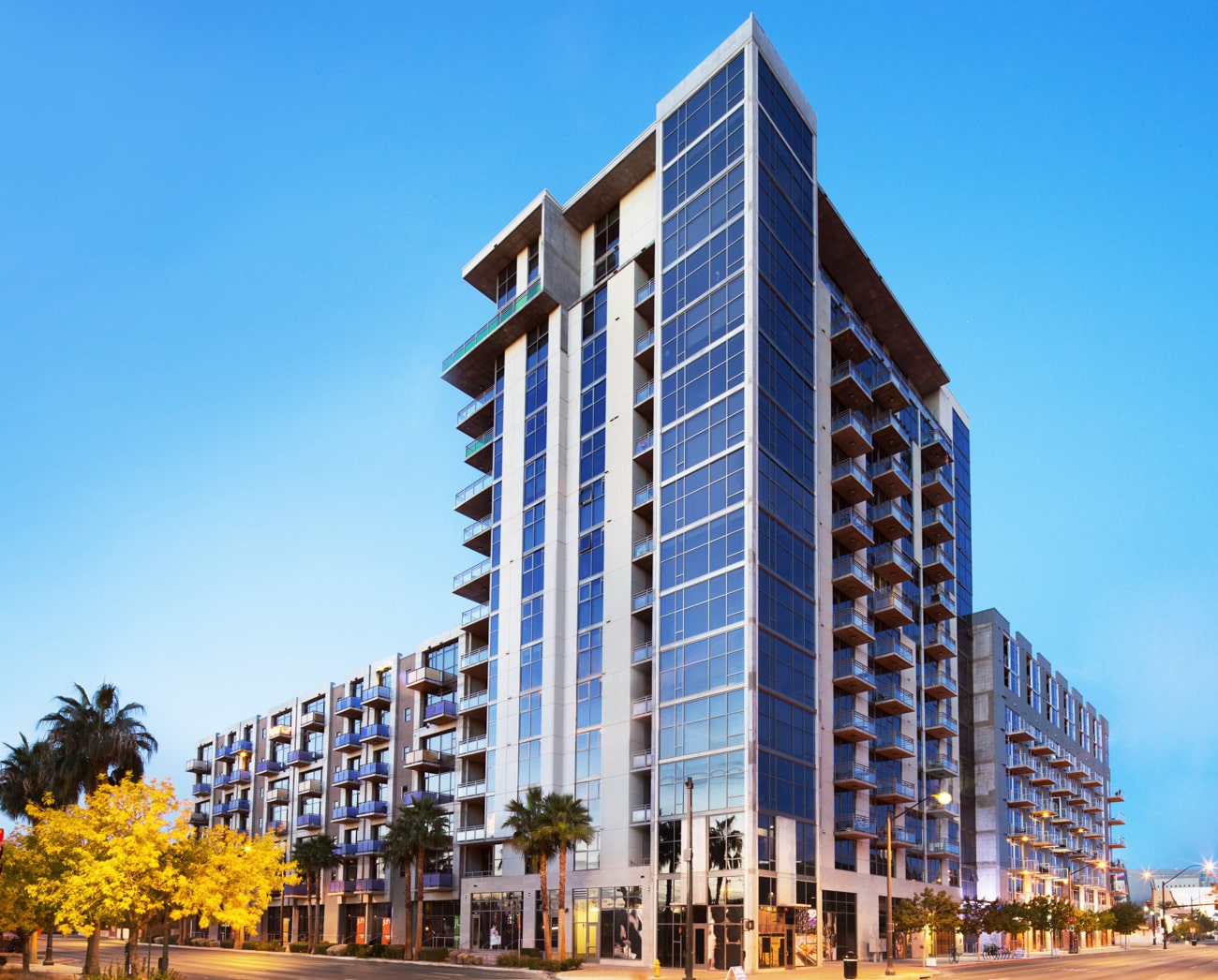
Architecture Photography in Las Vegas Juhl
Juhl
Juhl was built with the goal of revitalizing the downtown area. Starting construction in 2006, it was completed in 2008 and opened in 2009. This building houses luxury condos, studios, and one or two bedroom living options. The street level units are available for commercial use. In addition, the property has a pool and patio to make those hot summers more enjoyable. The importance of the building is the focus on live and work spaces. Sensing the growth and development of downtown, the builder wanted to provide a level of design that would fit within the existing cultural scene of the neighborhood. This building is interesting because it looks different depending on where you view it from. It is modern sleek, urban street, and refined residential, all in one city block.
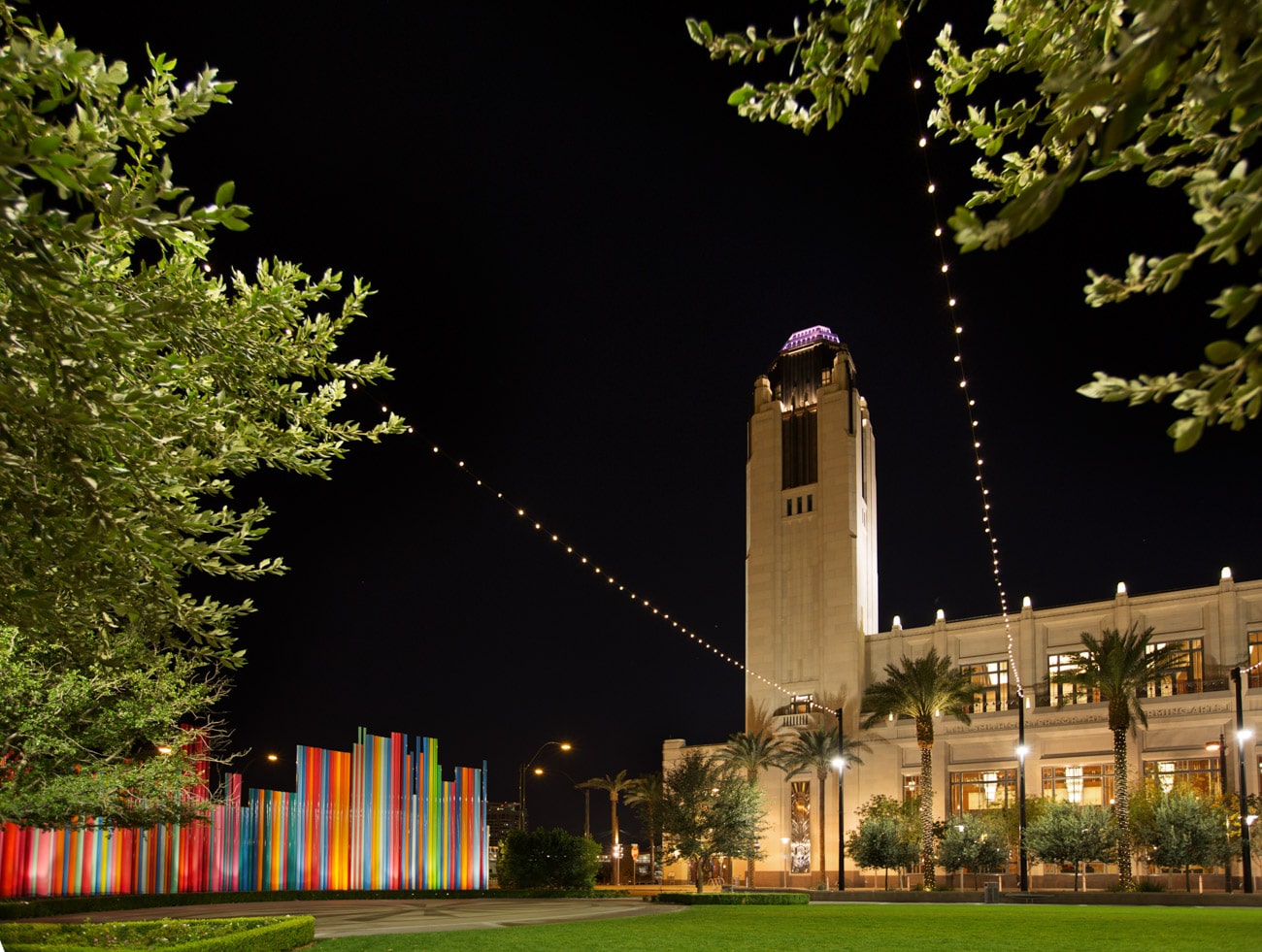
Smith Center for the Performing Arts
Smith Center for the Performing Arts
Las Vegas is such a large city. Yet until just a few years ago, one of the few major cities that lacked a performing arts center. Eventually, that changed when ground was broke in 2009. That’s when the world-class performing arts center began construction. This beautiful Neo Art Deco building opened in 2012 with a Gold LEED Certification. It is the crown jewel of the 61 acres known as Symphony Park. On the north side of the Smith Center there is a lush park that includes an outdoor stage and tribute statues. “Pipe Dream” is a public art sculpture created by one of Vegas’ own artists: Tim Bavington. Each color painted onto the vertical poles representing a different note of the song “Fanfare for the Common Man”. The 17-story main tower houses 47 bells and provides a new focal point to the Downtown Las Vegas skyline.

Atomic Liquors
Atomic Liquors
Built in 1945, Atomic Liquors was the first to obtain package liquor license in the city of Las Vegas. It is the oldest free standing bar and a landmark in Vegas. In the 1950’s, guests would watch the atomic blasts that were being tested hundreds of miles away from the roof. This is how the place came to be called Atomic Liquors, instead of its original name; Virginia’s Cafe. Eventually, in 2012 a new group bought The Atomic and restored it to its original charm. Therefore, attracting the hip and trendsetting crowds. During the remodeling, a floor safe was discovered. It was full of receipts and other paperwork from Atomic’s early days. The floor safe is in its original location and on display with a transparent glass cover to look inside. A building with this much history is key to this architecture photography in Las Vegas collection.
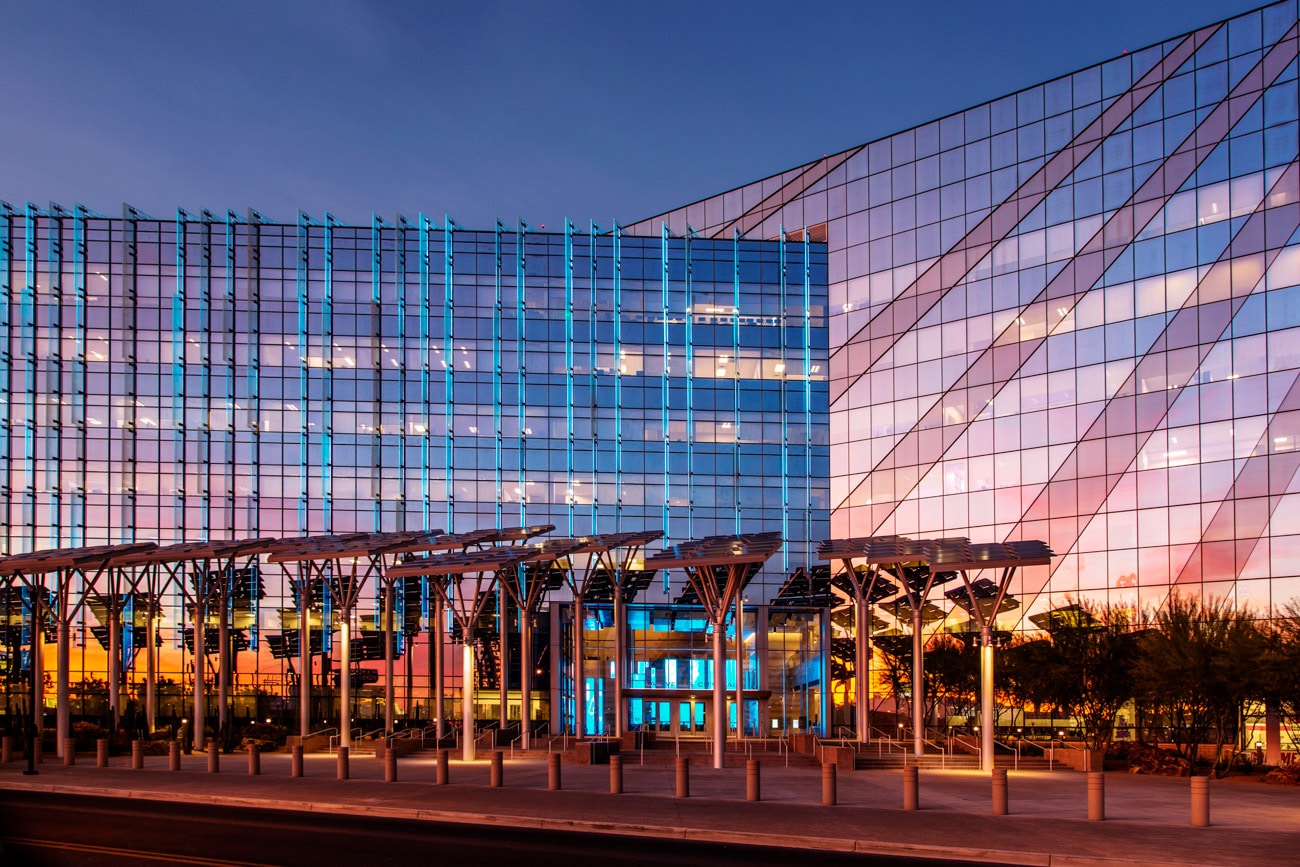
Architecture Photography in Las Vegas City Hall
Las Vegas City Hall
It’s a safe bet to say there are not many City Halls that are as flashy the one in Las Vegas. Few government offices have programmable LED displays on the front facade. However, do not be fooled in thinking Vegas is just all show. Behind all that glitz and glam is also a focus on being environmentally friendly. There are 33 solar trees at the front entry of the building. City Hall pays tribute to all that glitters, but behind those walls are the hard working minds that keep this city moving and expanding. A little known fact: this building had a brief cameo on the tv show “Parks and Recreation” as the City Hall for neighboring upscale city of Eagleton.
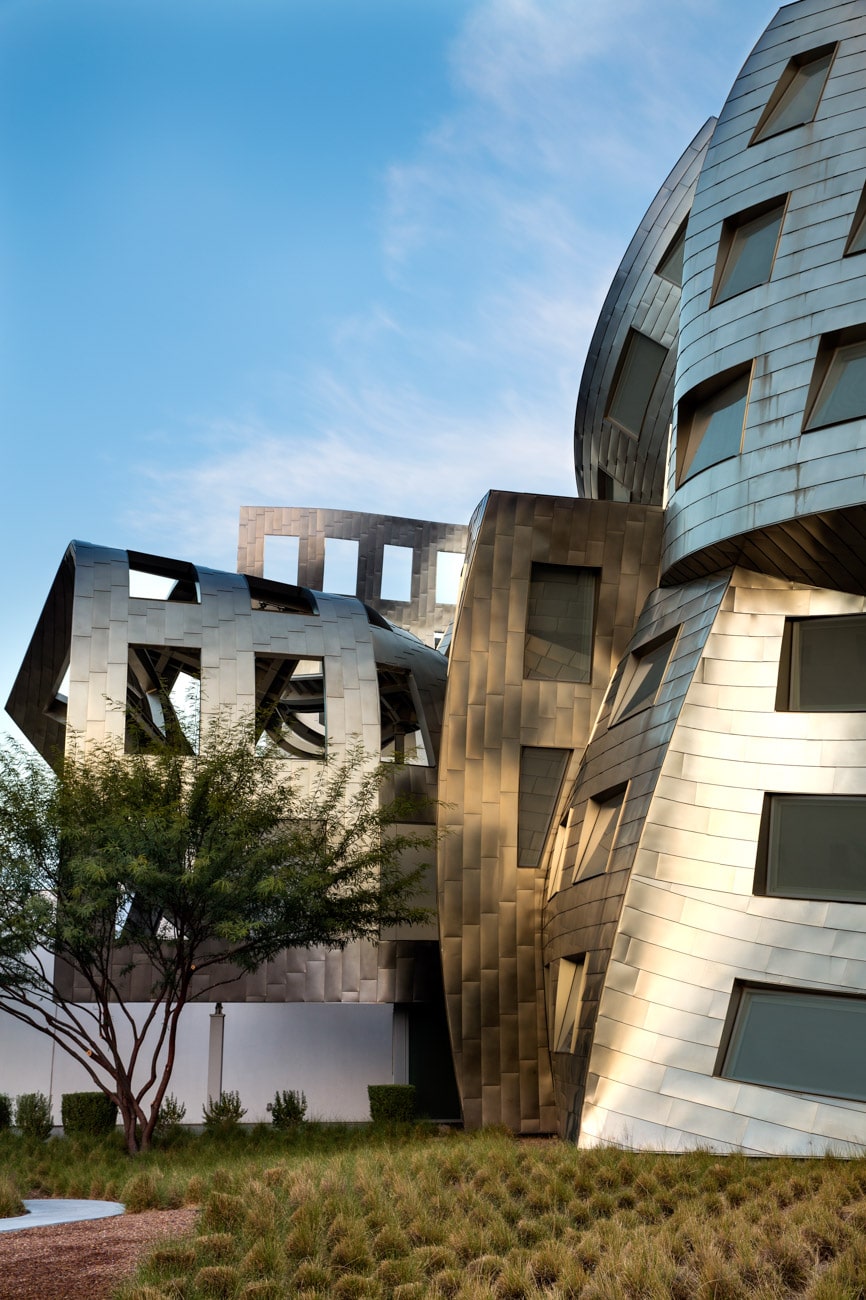
Lou Ruvo Center for Brain Health
Lou Ruvo Center for Brain Health
Built by the world famous architect Frank Gehry, this building is truly one-of-a-kind. Gehry has such a unique style that his buildings tend to become tourist attractions themselves. Like the Walt Disney Concert Hall in downtown Los Angeles, or perhaps the Louis Vuitton Foundation in Paris, for instance. Even the most casual fan of architecture can recognize his work instantly. This Gehry building is also special because it is the nation’s leading resource for treatment of brain diseases. Larry Ruvo named the facility to honor his father Lou Ruvo who suffered from Alzheimer’s Disease. He also created ‘Keep Memory Alive’ as one of the leading activist in the fight against Alzheimer. As a result, this unique building makes it highly interesting for anyone excited by architecture photography in Las Vegas.
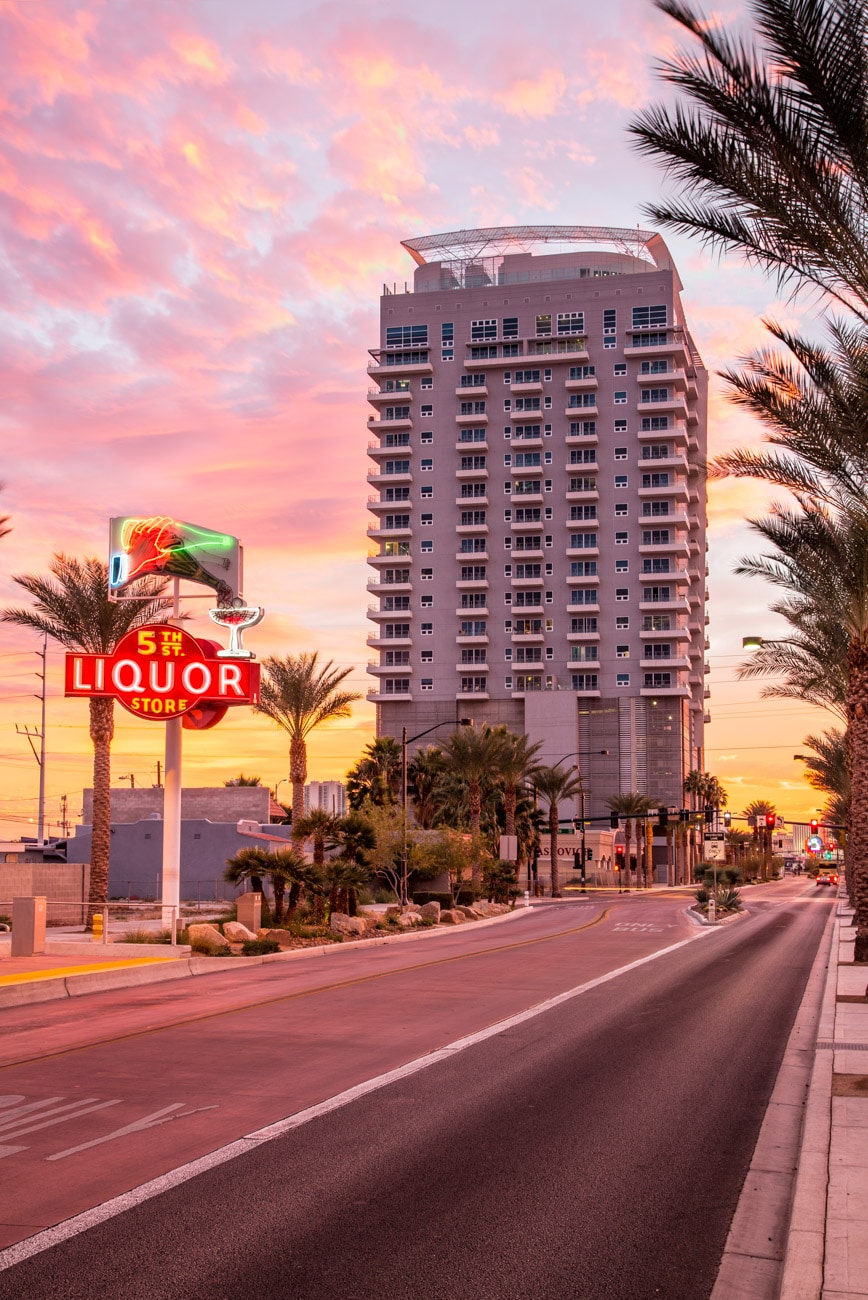
Newport Lofts
Newport Lofts
Hosting 168 units with loft style appeal, high ceilings, and great views of the whole valley, the Newport Lofts stands tall and proud in the heart of Downtown. This 23-story high rise condo was built 2006 when those in the real estate game were using phrases like “the Manhattanization of Las Vegas.” The roof features a dynamic structure that covers a jogging track, a pool, a gym, and a community center. In the foreground of this image is one of the many historic neon signs that have been repurposed after retirement as public art around the downtown streets.
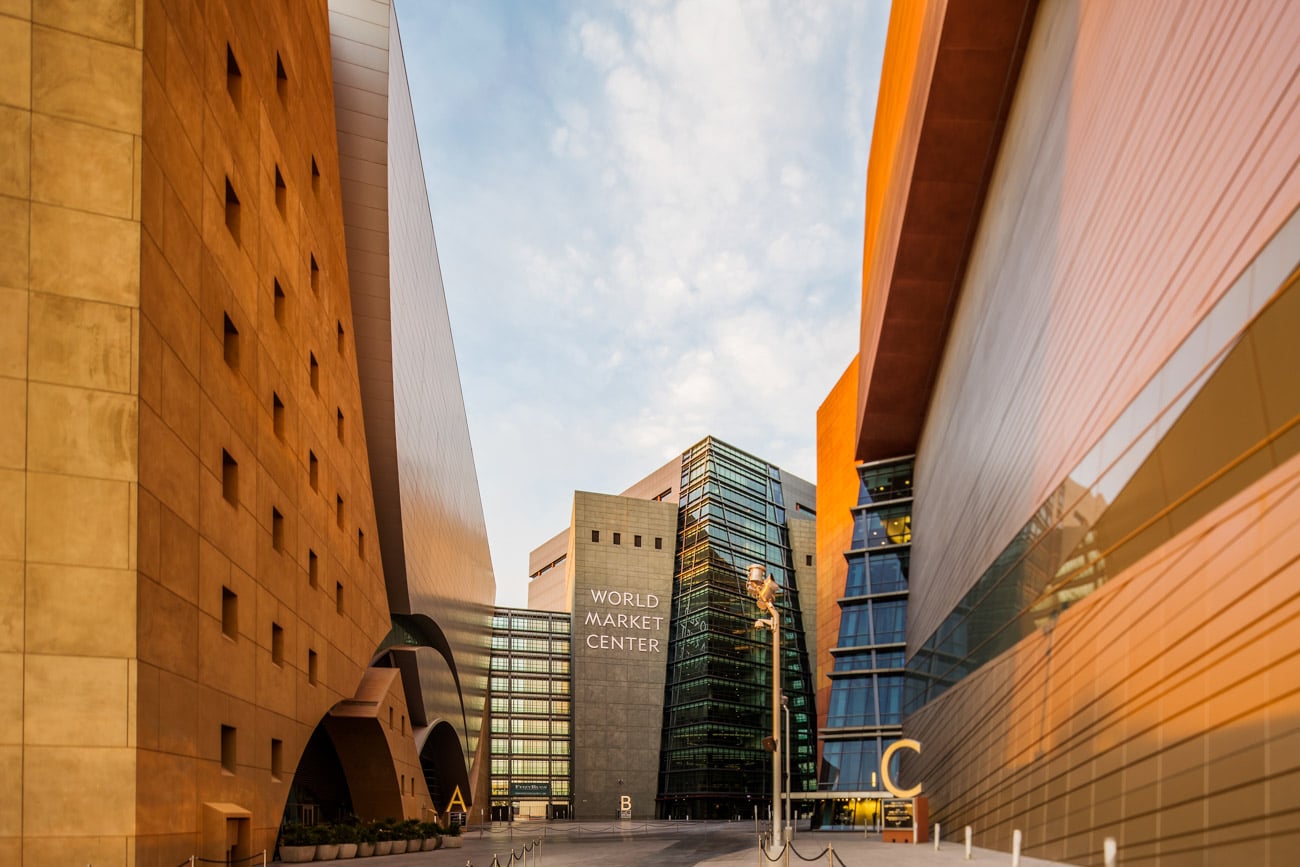
World Market Center
World Market Center
It’s an understatement to say, but there is nothing small about the World Market Center. In fact it holds several places in the Guinness Book of World Records for size related matters. First, it is the largest showcase for home and hospitality furnishings companies making it the international hub for the industry. This five million square foot center had its first building opened in 2002. It was followed by two more buildings, the last being Building C, which opened in July of 2008. The parking garage that accompanies the buildings is no small fry either at 175,000 square feet. It is capable of accommodating 3,600 vehicles. The space also has three pavilions on site that have been deemed the largest tents in the United States by Guinness Book of World Records.
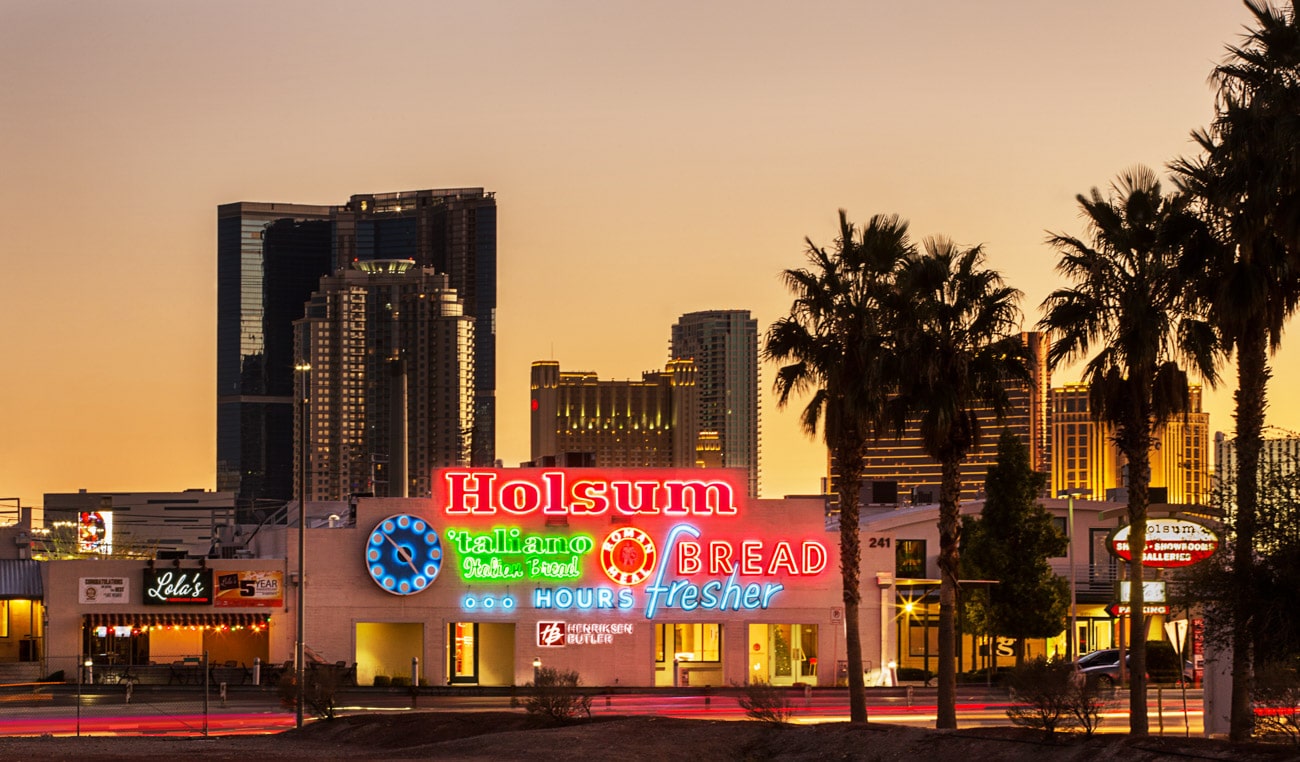
Holsum Lofts
Holsum Lofts
A fantastic example of breathing new life into an old building. The Holsum Lofts was one of the first to be repurposed for the booming business growth in Downtown Las Vegas. Started in 1954 as a bakery, the building produced bread until 2002 when it closed its doors. Sitting in debt and vacant for only a little while, the building was quickly recognized as a unique structure with its vintage neon signage and historic stature. After being renovated, it began leasing out spaces for restaurants, offices, and creative studios. Thus offering the quickly growing downtown yet another place to grab a bite or set up shop. The classic neon sign and the golden desert sunset makes this one of our favorites in this architecture photography collection.
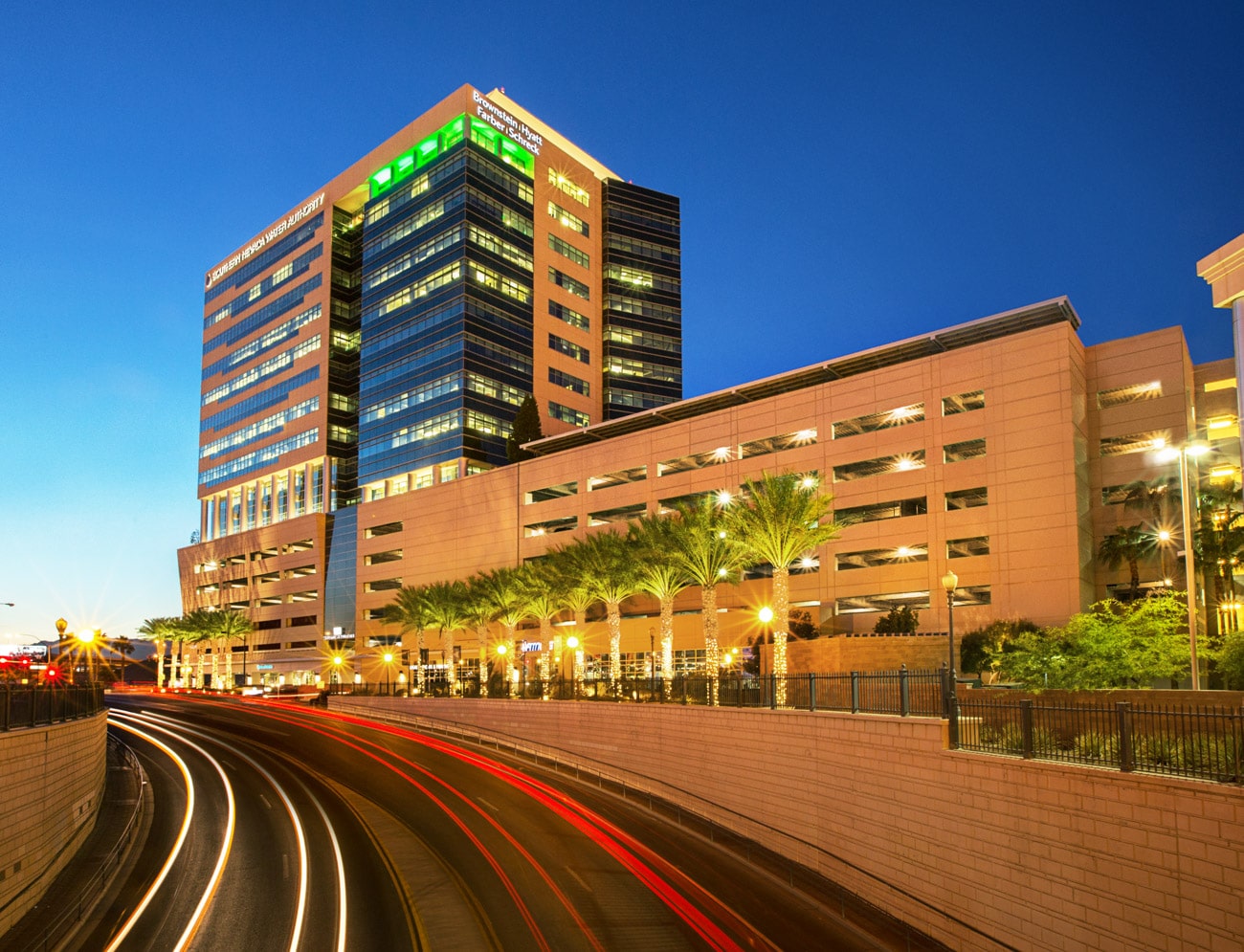
Molasky Building
Molasky Building
The first corporate building downtown to be LEED Gold Certified, the Molasky Building has set the standard for what the future of architecture can be. By focusing on using renewable energies, minimized water usage, building-wide recycling programs, and a bike sharing program for its tenants. As a result, this multiple award-winning building is the largest privately owned LEED building in the southwestern United States. These features create a healthy and welcoming work space for it’s tenants including the Molasky Group of Companies. Also, it is home to the Las Vegas branch of the I.R.S., and the Southern Nevada Water Authority. It regularly welcomes visitors from around the world who tour the building to learn about its design and efficiencies for their own green building projects.
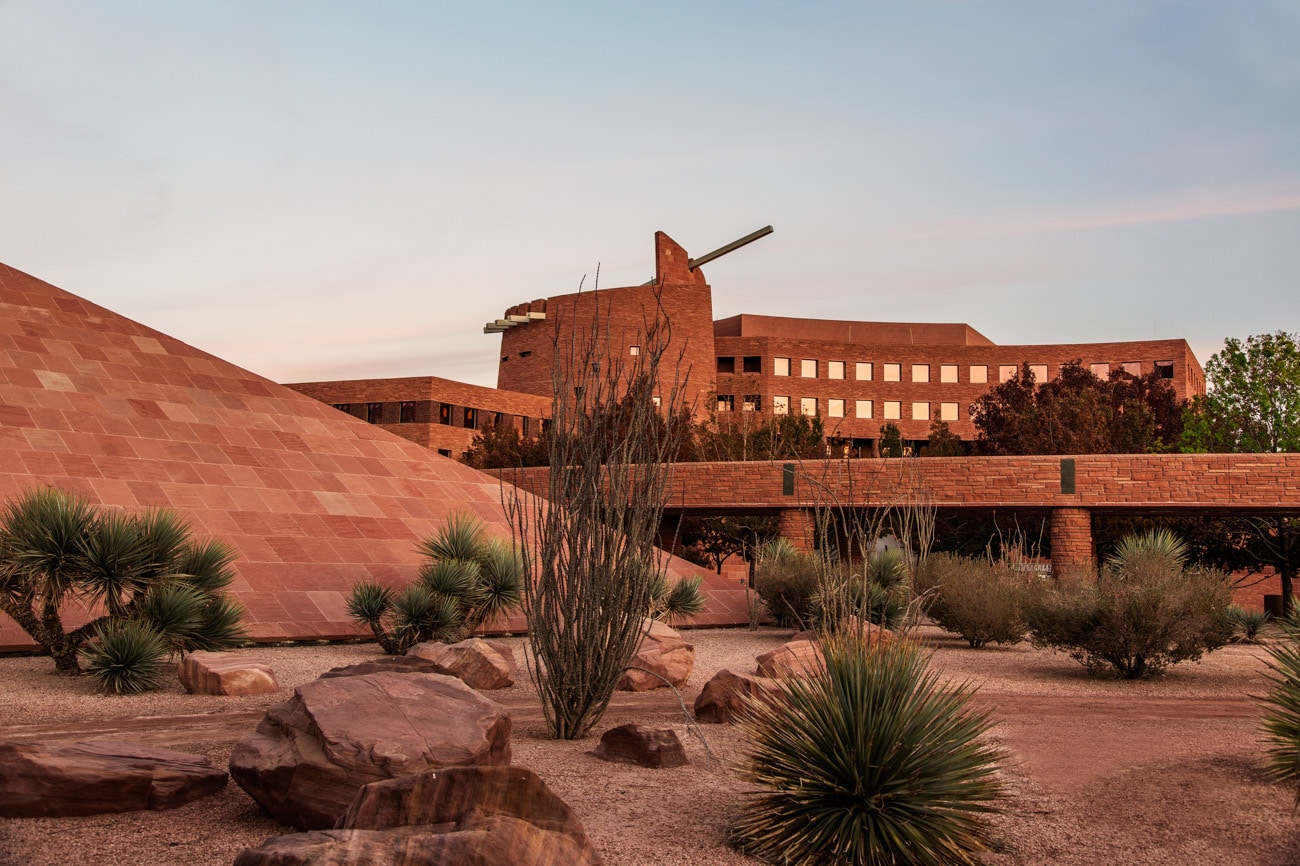
Architecture Photography in Las Vegas Clark County Government Center
Clark County Government Center
The creation of this building simplified the County Government’s services into one central building. This is an architectural masterpiece of functionality and straightforward design. That is to say, it is completely focused on civic order and supporting community functions. The striking facility is designed to grow with the needs of the government over the next fifty years. It also includes a fully landscaped amphitheater that hosts public events and performances. Designed by Curtis W. Fentress (of Denver International Airport fame) and completed in 1995. The distinct pyramid structure in front is called the Community Room. This facility seats up to 400 people for civic gatherings. It also functions as the County’s Emergency Operations Center. It has received awards including “Best Non-Hotel Architecture” from the Las Vegas Review Journal People’s Choice award for multiple years.
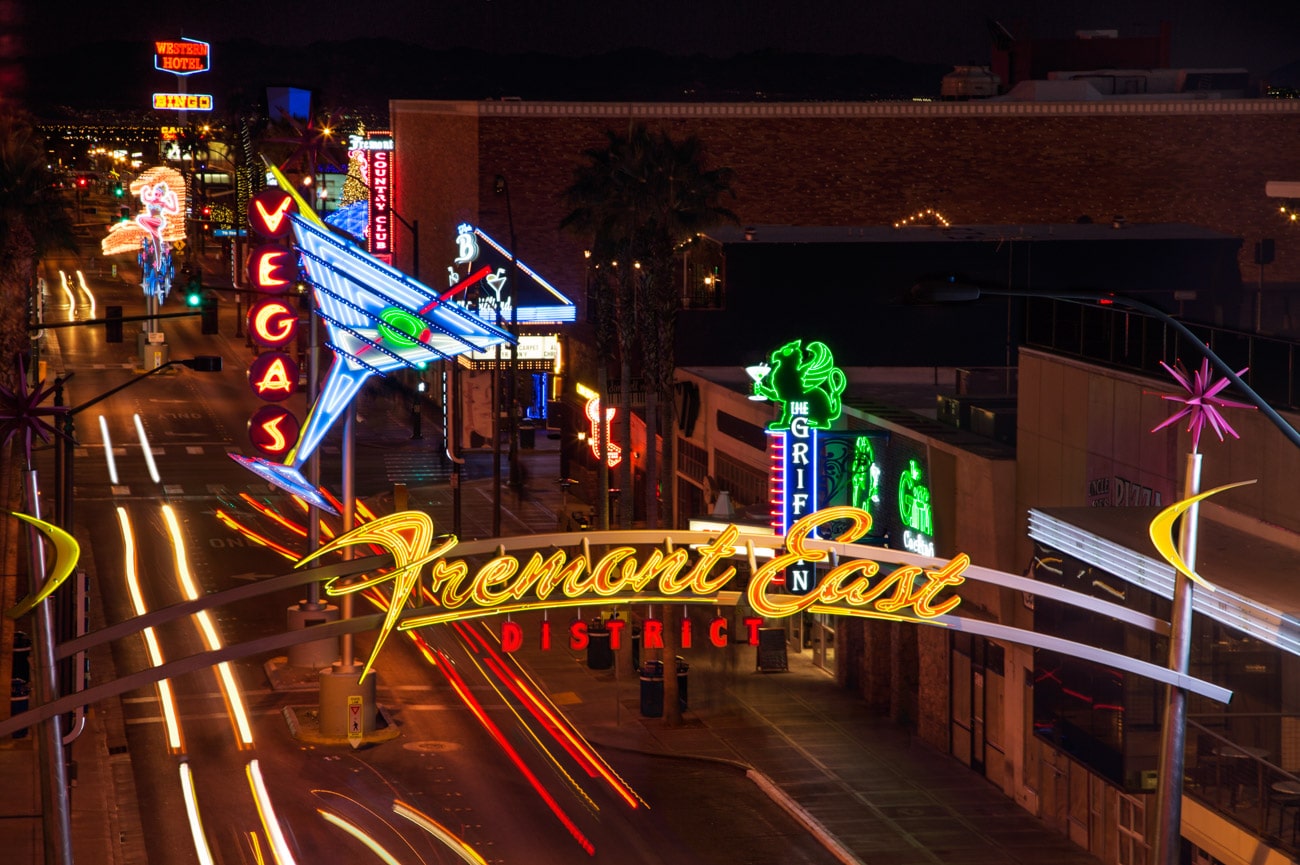
Fremont East District
Fremont East
This once ignored section of the world famous Fremont Street has been transformed into a destination for tourist and locals alike in less than a decade. With a five million dollar investment the area was transformed with classic neon signs, wider sidewalks, and unique bars and restaurants. As a result, this development has created an alternative nightlife, entertainment, and restaurant scene for those seeking something different then what Vegas is commonly know for. Because of this, the area is now the weekend destination for Las Vegas residents from all over the valley.
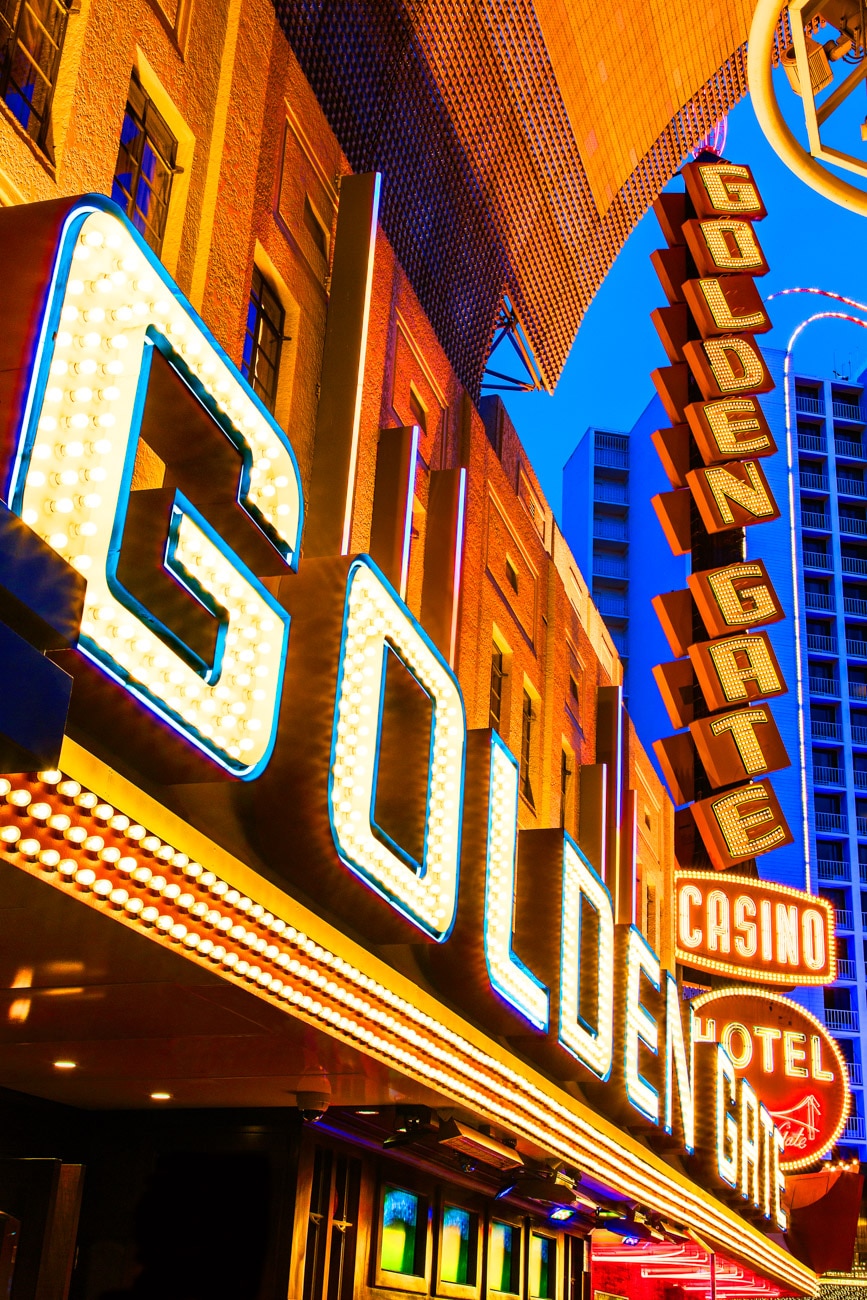
Architecture Photography in Las Vegas Golden Gate
Golden Gate
Firstly, to say the Golden Gate is a Las Vegas institution is an understatement. The corner lot at Fremont and Main sold for $1750 in 1905. Within a year, a room at the then named Hotel Nevada was available for a dollar per day. In 1907 the first telephone in Las Vegas was installed in the lobby with the phone number of ‘1’. This antique telephone is still on display at the hotel today. In 1931 the location received a gaming license under the new name of the ‘Sal Sagev’. This name is ‘Las Vegas’ cleverly spelled backwards. In 1955, a San Francisco group took over and began the Golden Gate Casino. After that, they introduced their world famous Shrimp Cocktails just a few years later. A symbol of Las Vegas’ constant evolution for over 110 years, this icon of Fremont Street continues to be a classic.
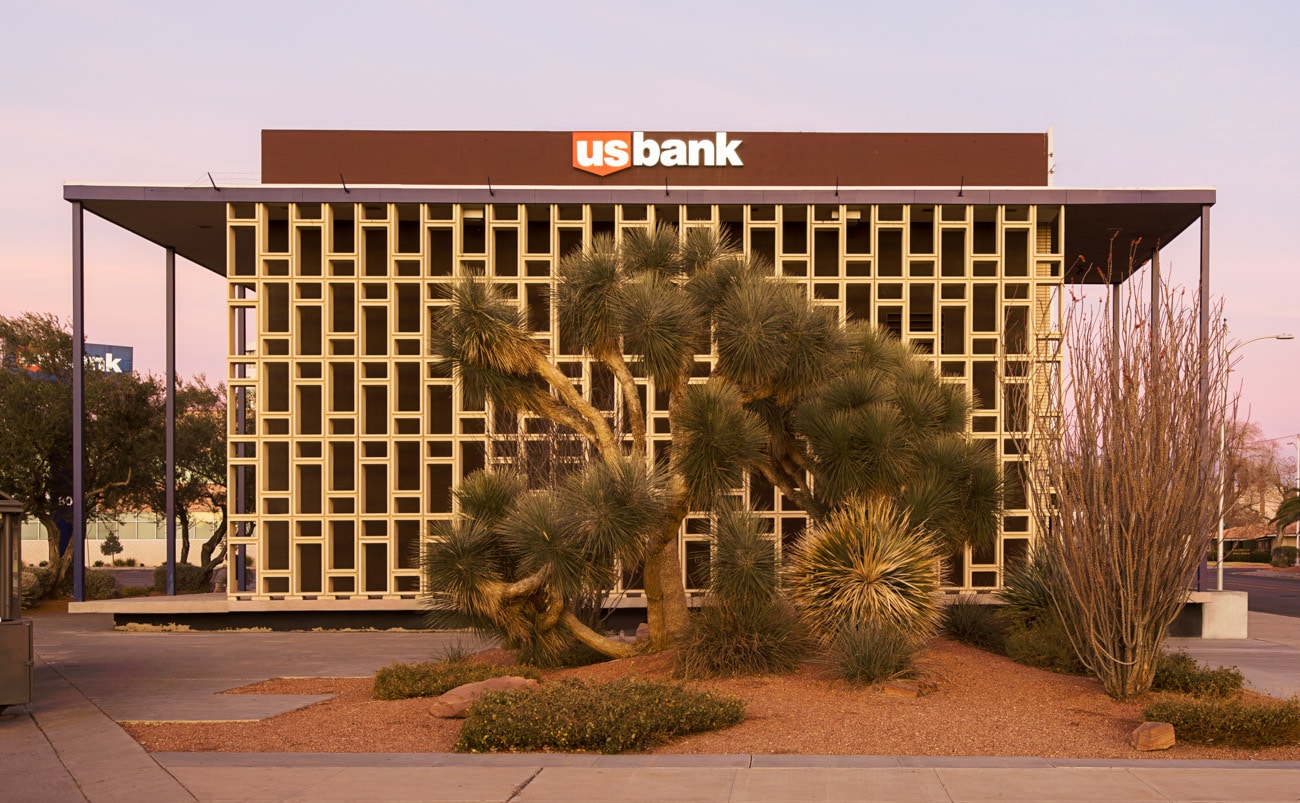
US Bank
US Bank
The national chain of banks inhabits an outstanding sample of late 60’s architecture. This icon on East Charleston lives just a few blocks from the Las Vegas Strip. A simple three story rectangle demands attention with the help of the repeating patterned breezeway wall on the east side. Painted a contrasting cream color from the rest of the building’s dark brown color. Consequently, this featured design wall floats away from the rest of the building to play with negative space as well depth. The mature desert garden enhances the sense of preservation of the building’s historic aura. What a perfect fit for this collection of architecture photography in Las Vegas.
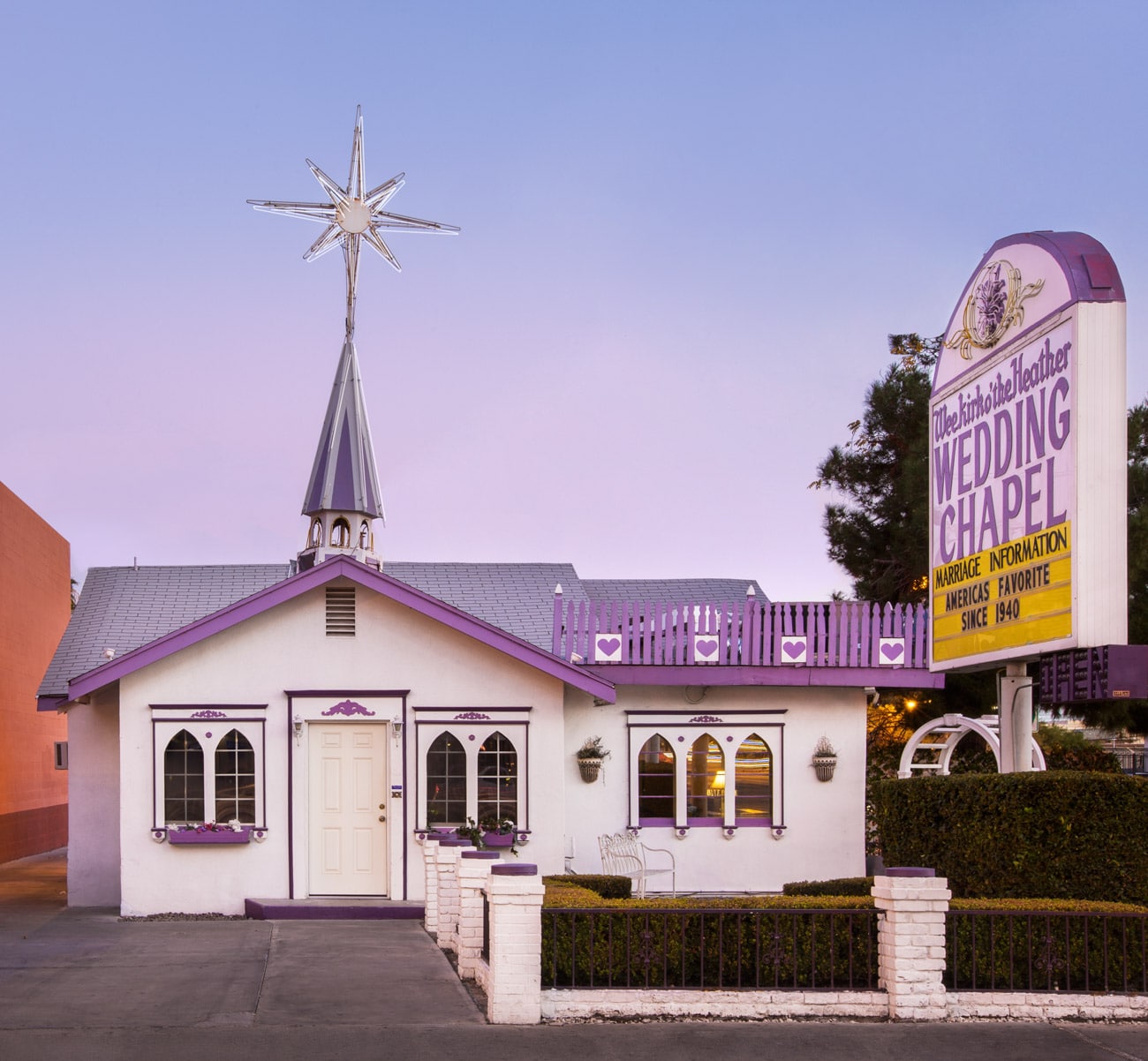
Wee Kirk o the Heather Wedding Chapel
Wee Kirk o’the Heather Wedding Chapel
No collection of architecture photography in Las Vegas would be complete without including a wedding chapel. Scottish for “The Little Chapel of the Lucky Flowers”, this charming little landmark on the Las Vegas Blvd has been in operation since 1940. Therefore, this makes it the oldest chapel in Las Vegas which is the wedding capital of the world. Millions of people who’ve been married by an Elvis impersonator should appreciate the Wee Kirk. It was the first to start this very Vegas way of exchanging vows.
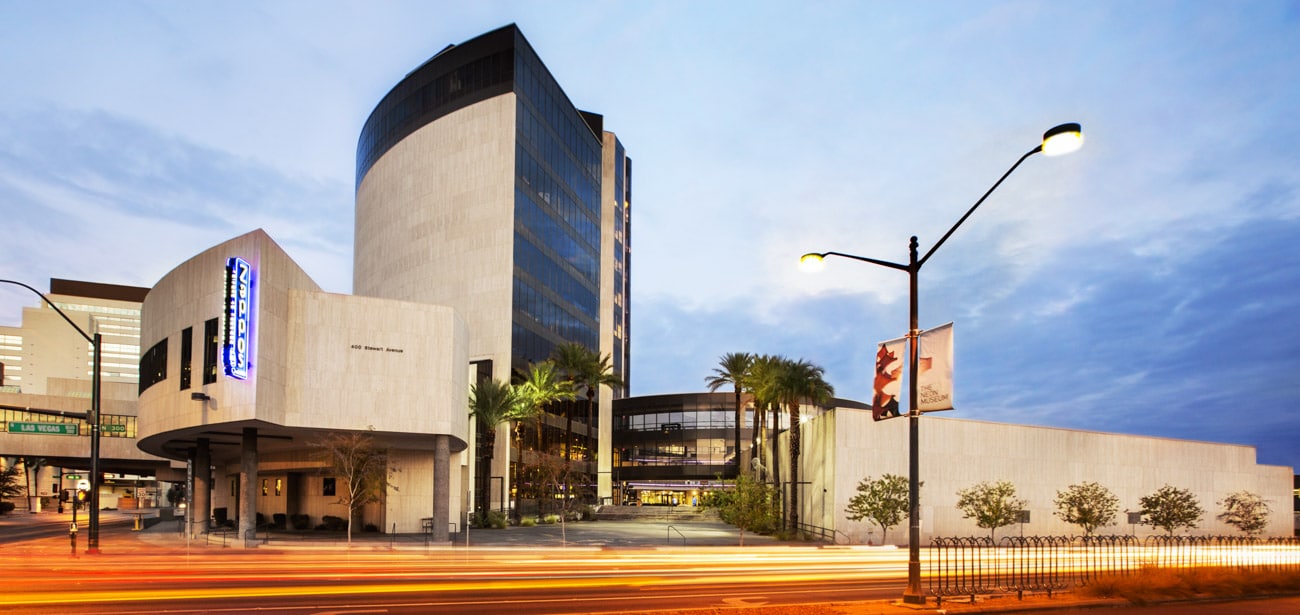
Architecture Photography in Las Vegas Zappos Headquarters
Zappos
It’s not often when a company moves into a new office space that an entire neighborhood is changed for the better. But that is exactly what happened when the online shoe retailer relocated to Downtown Las Vegas. Formerly the company was located in nearby Henderson, Nevada. So after the City government began construction on the new City Hall facility on Main Street, the online retailer decided this would be repurposed for their company headquarters. Originally completed in 1973, this 11-story shining example of 1960’s modern architecture. It underwent a $48 million dollar renovation over a two year period before the company moved in 2013.
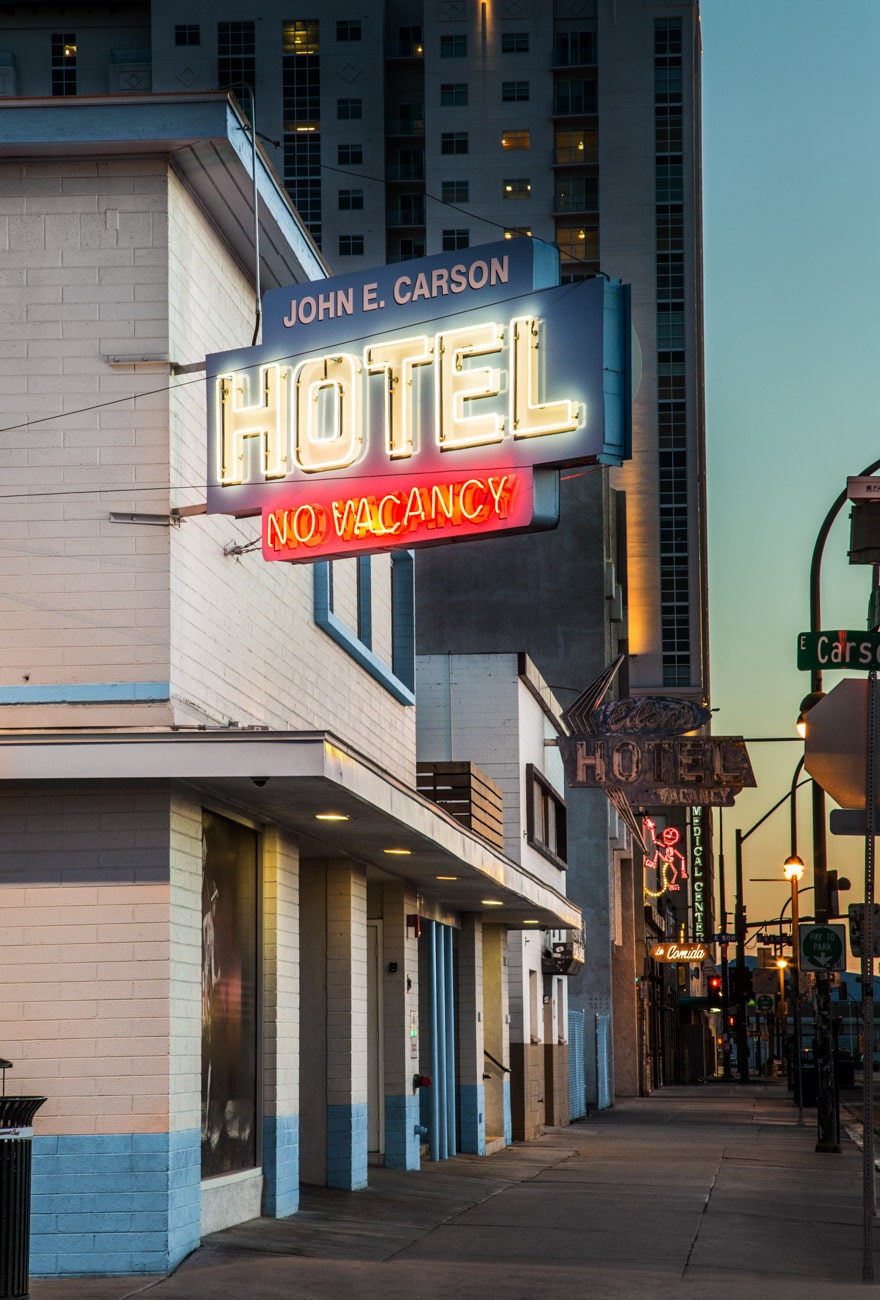
John E Carson
John E. Carson
Originally built around 1955, the John E Carson served as a 65 room hotel. Purchased by investors in 2012, the building was rehabilitated as office, restaurant and retail spaces. This new life into the building has drawn several one-of-a-kind restaurants and creative businesses. Because of this, it now includes a sushi restaurant, a juice bar, and a yoga studio. Above all, preserving the history of the building’s structure while updating the space was a top priority. A raw feel and plenty of shared outdoor spaces gives this remodel a lively and urban appeal. The original neon sign was left untouched during the remodel as a reminder to the long history of the building.
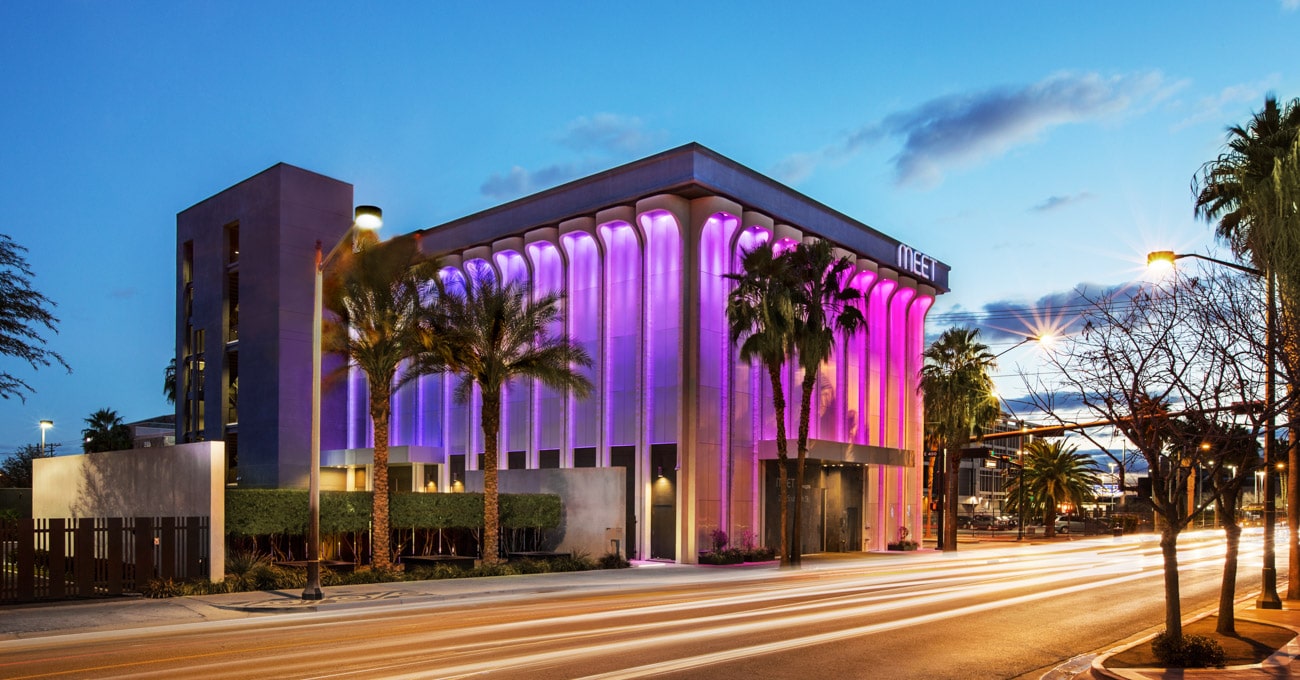
Architecture Photography in Las Vegas Meet
Meet
Reopened as MEET in 2010, this hidden gem is an example of a repurposed building. It resides just a few blocks from Fremont Street Experience. This three-story former bank has been is packed with top of the line technology. It prides itself on being a completely customizable event and convention space. The color changing lights provide a wow factor to the distinct arches at the top of the building. As a result, this structure truly stands out after sunset.
In conclusion, as architecture photography experts in Las Vegas, we are honored to highlight the city we love. We poured our heart and soul into this architecture photography. This collection of images was featured in a gallery show at City Hall. These architecture photography images have since been put on display at government buildings all over the Las Vegas valley. We hoped you’ve enjoyed this collection as much as we do!

